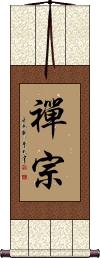Many custom options...
And formats...

禅宗 in Chinese / Japanese...
Buy an 禅宗 calligraphy wall scroll here!
Zen Buddhism
禪宗 is one way to title “Zen Buddhism.” Because the original pronunciation of Zen in Chinese is Chan, you'll also see this expressed as Chan Buddhism.
From the Buddhist Dictionary:
The Chan, meditative or intuitional, sect is usually said to have been established in China by Bodhidharma, the twenty-eighth patriarch, who brought the tradition of the Buddha-mind from India. This sect, believing in direct enlightenment, disregarded ritual and sūtras and depended upon the inner light and personal influence for the propagation of its tenets, founding itself on the esoteric tradition supposed to have been imparted to Kāśyapa by the Buddha, who indicated his meaning by plucking a flower without further explanation. Kāśyapa smiled in apprehension and is supposed to have passed on this mystic method to the patriarchs. The successor of Bodhidharma was 慧可 Huike, and he was succeeded by 僧璨 Sengcan, 道信 Daoxin, 弘忍 Hongren, 慧能 Huineng, and 神秀 Shenxiu, the sect dividing under the two latter into the southern and northern schools: the southern school became prominent, producing 南嶽 Nanyue and 靑原 Qingyuan, the former succeeded by 馬祖 Mazu, the latter by 石頭 Shitou. From Mazu's school arose the five later schools.
Not the results for 禅宗 that you were looking for?
Below are some entries from our dictionary that may match your 禅宗 search...
| Characters If shown, 2nd row is Simp. Chinese |
Pronunciation Romanization |
Simple Dictionary Definition |
禅宗 see styles |
zenshuu / zenshu ぜんしゅう |
More info & calligraphy: Zen Buddhism |
禪宗 禅宗 see styles |
chán zōng chan2 zong1 ch`an tsung chan tsung Zenshū |
More info & calligraphy: Zen BuddhismThe Chan, meditative or intuitional, sect usually said to have been established in China by Bodhidharma, v. 達, the twenty-eighth patriarch, who brought the tradition of the Buddha-mind from India. Cf. 楞 13 Laṅkāvatāra sūtra. This sect, believing in direct enlightenment, disregarded ritual and sūtras and depended upon the inner light and personal influence for the propagation of its tenets, founding itself on the esoteric tradition supposed to have been imparted to Kāśyapa by the Buddha, who indicated his meaning by plucking a flower without further explanation. Kāśyapa smiled in apprehension and is supposed to have passed on this mystic method to the patriarchs. The successor of Bodhidharma was 慧可 Huike, and he was succeeded by 僧璨 Sengcan; 道信 Daoxin; 弘忍 Hongren; 慧能 Huineng, and 神秀 Shenxiu, the sect dividing under the two latter into the southern and northern schools: the southern school became prominent, producing 南嶽 Nanyue and 靑原 Qingyuan, the former succeeded by 馬祖 Mazu, the latter by 石頭 Shitou. From Mazu's school arose the five later schools, v. 禪門. |
禅宗寺 see styles |
zenshuuji / zenshuji ぜんしゅうじ |
(personal name) Zenshuuji |
禅宗様 see styles |
zenshuuyou / zenshuyo ぜんしゅうよう |
(noun - becomes adjective with の) (See 唐様・2) traditional Zen-style architecture |
禪宗永嘉集 禅宗永嘉集 see styles |
chán zōng yǒng jiā jí chan2 zong1 yong3 jia1 ji2 ch`an tsung yung chia chi chan tsung yung chia chi Zenshū yōka shū |
Chanzong yongjia ji |
禪宗永嘉集科註說誼 禅宗永嘉集科注说谊 see styles |
chán zōng yǒng jiā jí kē zhù shuō yí chan2 zong1 yong3 jia1 ji2 ke1 zhu4 shuo1 yi2 ch`an tsung yung chia chi k`o chu shuo i chan tsung yung chia chi ko chu shuo i Zenshū Yōka shū kachū setsugi |
Annotated Redaction of the Text and Commentaries to the Compilation of Yung-chia of the Chan school |
禪宗辭典禪林象器箋 禅宗辞典禅林象器笺 see styles |
chán zōng cí diǎn chán lín xiàng qì jiān chan2 zong1 ci2 dian3 chan2 lin2 xiang4 qi4 jian1 ch`an tsung tz`u tien ch`an lin hsiang ch`i chien chan tsung tzu tien chan lin hsiang chi chien Zenshū jiten zenrin zōkisen |
Encyclopedia of Zen Monasticism |
The following table may be helpful for those studying Chinese or Japanese...
| Title | Characters | Romaji (Romanized Japanese) | Various forms of Romanized Chinese | |
| Zen Buddhism | 禪宗 禅宗 | zen shuu / zenshuu / zen shu | chán zōng chan2 zong1 chan zong chanzong | ch`an tsung chantsung chan tsung |
| In some entries above you will see that characters have different versions above and below a line. In these cases, the characters above the line are Traditional Chinese, while the ones below are Simplified Chinese. | ||||
Successful Chinese Character and Japanese Kanji calligraphy searches within the last few hours...




